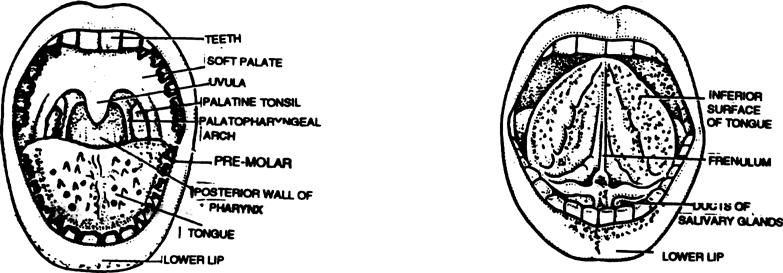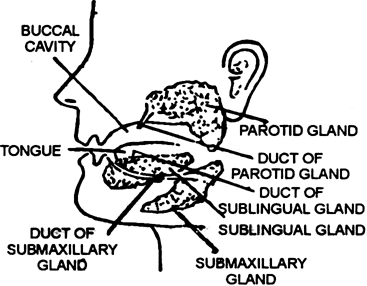
Fig. Structures seen in the widely open mouth Fig. The inferior surface of the tongue
Salivary glands : There are three pairs of salivary glands in man. They secrete about 1 to 1.5 litres of saliva in 24 hours. Three pairs of salivary glands are :
1 .Parotid salivary glands : They are present on the sides of the face below and in front of ears. These are the largest salivary glands. They secrete saliva into the vestibule just opposite to the upper second molar teeth.

Human salivary glands
2. Sublingual glands : These glands lie under the front part of the tongue. These secrete the saliva under the tongue by sublingual ducts.
3. Submaxillary glands : These glands are present at the angles of the lower jaw. These also secrete saliva below the tongue.
1. Teeth of carnivores are pointed and sharp for killing their prey and tearing it into pieces small enough to swallow.
2. They have large stomach for food storage, since they eat large and infrequent meals.
4. They have shorter small intestine.
Digestive tract of herbivores ;
1. Teeth of herbivores are flat for crushing and grinding plant materials.
2. A herbivore has a smaller stomach, because it eats smaller amounts of food more frequently.
4. They have larger small intestine.
Large intestine : It has a length of 1.5 m. It consists of caecum, colon and rectum.
The large intestine has three parts :
1. Caecum : is a small blind sac which hosts some symbiotic micro-organisms. It is 8 cm in length. The caecum gives a blind tubular diverticulum called vermiform appendix. A narrow finger-like tubular projection, the vermiform appendix which is a vestigial organ, arises from the caecum. The caecum and vermiform appendix are vestigial in man. The ileum opens into caecum ; the opening is guarded by ileocaecal valve. It checks the back flow of the food from caecum into ileum.
2. Colon : The caecum continues into colon. The colon has 3 parts - an ascending, a transverse and a descending part.
(a) Ascending colon : It runs towards anterior end of the abdominal cavity.
(b) Transverse colon : It runs horizontally and joins the two ascending and descending colons.
(c) Descending colon : It runs towards posterior side of the abdominal cavity and leads into sigmoid colon.
The colon has longitudinal groove called taeniae coli. On either side of taeniae coli there are pouches called haustera.
Functions :
i. In colon maximum amount of water is absorbed.
ii. Vitamin K and vitamin B are synthesised by the action of bacteria in colon.
(3) Rectum : It has a length of 12 cm. The rectum leads into anal canal which has a length of 2-3 cm. It opens outside via anus.
Disorders of digestive system : There are following common disorders of digestive system in addition to infections of parasites.
1. Jaundice : In this the liver is affected and skin and eyes turn yellow due to the deposit of bile pigments (billirubin and biliverdin) in liver which pass into blood.
2. Vomiting : The ejection of stomach contents through the mouth. This reflex action is controlled by the vomit centre in the medulla. A feeling of nausea precedes vomiting.
3. Diarrhoea : The abnormal frequency of bowel movement and increased liquidity of the faecal discharge is known as diarrhoea.Tthe absorption of water is reduced. It occurs when less water is absorbed in colon from food.
4. Constipation : It occurs when excess of water is absorbed from faecal mater. In constipation the faeces are retained within the rectum as the bowel movements occur irregularly.
5. Indigestion : It is the process in which the food is not properly digested leading to feeling of fullness. The cause of indigestion are inadequate enzyme, secretion, anxiety, food poisoning, over eating and spicy food.
